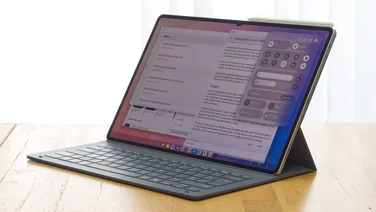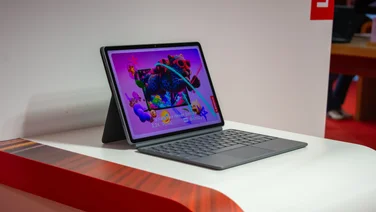To help us provide you with free impartial advice, we may earn a commission if you buy through links on our site. Learn more











- Larger display
- Fast performance
- Fantastic battery life
- On the heavy side
- Only three years of OS updates
The OnePlus Pad 3 is the brand’s latest swing at unseating Apple’s tablet supremacy. Its predecessor, the OnePlus Pad 2, was our favourite alternative to the 10.2in Apple iPad last year but, for this generation, OnePlus is aiming even higher up the food chain.
With the latest iteration of the iPad dropping in price and the OnePlus Pad 3 coming in slightly more expensive than its predecessor, its nearest rival is now Apple’s immensely powerful M3 Apple iPad Air (2025). And let me tell you, the OnePlus Pad 3 gives Apple a good run for its money.
OnePlus Pad 3 review: What do you get for the money?
The OnePlus Pad 3 is bigger than the Pad 2 and that means it’s more expensive too – but fortunately, not by much. The base model with 12GB of RAM and 256GB of storage space costs £529 – a £30 price increase over last year – and the 16GB/512GB version is priced at £599.
The M3 Apple iPad Air (2025) starts at £560 for the 11in model with 128GB of storage and goes all the way up to a hefty £1,299 for the 1TB 13in model. Those extra storage options and the blisteringly fast M3 chipset are the biggest benefits of choosing the iPad, but you’ll have to pay a fair bit more for the privilege while also accepting a measly 60Hz display.











The OnePlus Pad 3’s display matches the larger iPad Air’s display for size now, measuring 13.2in across the diagonal with the resolution a sharp 3,392 x 2,400 and the refresh rate a smooth 144Hz. There’s an 8-megapixel selfie camera set into one of the long bezels, the same as on the Pad 2, while on the rear a 13-megapixel main camera is tucked into a small pill-shaped housing in the top-right corner.
The rear and frame are constructed from aluminium, and there’s only one colour option: the sophisticated Stormy Blue seen here. Overseas customers get a silver variant, too, but that’s something we in the UK miss out on.











Surrounding that larger screen is a body that is both taller and wider than the previous model, measuring 290 x 210mm (WxH). Despite growing in those dimensions, it has also slimmed down a little, measuring 6mm thick compared to 6.8mm on the Pad 2. It’s a fair bit heavier, though, swelling from 584g to 675g.
Inside, the 4.32GHz Snapdragon 8 Elite chipset shows up in a tablet for the first time, having thus far only appeared on flagship smartphones, and it’s joined by 12GB or 16GB of RAM and 256GB or 512GB of storage. The battery is bigger than the Pad 2’s (12,140mAh versus 9,510mAh) and charging has been upped from 67W to 80W.











Finally, there are a few optional accessories you can pair with the Pad 3. The OnePlus Stylo 2 (£99) is the same pencil used by the Pad 2, and I’ve always found it to be a comfortable, accurate little scribbler. You also have a couple of case options, one without a keyboard (£59) and one with a keyboard (£169).
If you want to make the Pad 3 a laptop replacement, keyboard and stylus included, you’re looking at £797 for the 256GB model or £867 for the 512GB. That sounds pricey, but the equivalent iPad Air with the Pencil Pro and Magic Keyboard would set you back an eye-watering £1,327 for the 256GB and £1,527 for the 512GB, so the OnePlus is actually pretty good value by comparison.
What does it do well?
The Pad 2’s biggest accolade was that it debuted the Snapdragon 8 Gen 3 chipset in tablet form but I found that, while multi-core performance was as exceptional as expected, the single-threaded results were a little underwhelming.











OnePlus has clearly addressed this issue because, in also being the first tablet to feature the Snapdragon 8 Elite SoC, the Pad 3 delivers some of the fastest performance I’ve ever seen from an Android tablet. Single-core results manage to keep pace with the iPad Air – although Apple still secures a 30% lead in the multi-core part of this test.
More impressively, the OnePlus Pad 3 absolutely wipes the floor with the Samsung Galaxy Tab S10 Ultra, which is quite a bit more expensive, starting from £1,199. In the single-core results, the OnePlus Pad 3 scored around 49% higher than the Samsung, and it pulled 26% ahead in the multi-core test. It may not quite beat Apple, but this is one of the fastest Android tablets you can buy right now.
The Snapdragon 8 Elite continues to impress in the gaming stakes, tying with the iPad Air for the fastest offscreen (1080p) performance while leaving the rest of the challengers in the dust. The on-screen (native resolution) may look like the OnePlus Pad 3 is weaker than the iPad Air and Tab S10 Ultra, but both of those tablets have lower resolution screens, helping them to appear faster in that particular test. For comparing raw power, the offscreen results are the metric to judge here.
The other side of the Snapdragon 8 Elite coin has always been excellent power efficiency, and it continues to impress in tablet form. Despite its massive 13.2in display, the OnePlus Pad 3 outlasted most of the competition in our looping video test, with a fantastic result of 16hrs 1min. Only the Honor Magic Pad 2 does any better, but that has a smaller 12.3in screen to light up, so this is still very impressive for the OnePlus.
As for display quality, that’s pretty decent, too. The screen is as sharp and responsive as before, while brightness gets a little bit better. With auto brightness disabled, the maximum the screen was able to reach was 520cd/m2, while switching to adaptive brightness and shining a torch on the light sensor pushed it up to 746cd/m2. Compared to the Pad 2 (496cd/m2 and 690cd/m2, respectively) that’s a small improvement but a welcome one nonetheless.
Colour accuracy improves upon the last generation even more. There are three colour profiles to choose from, with Vivid and Pro targeting the DCI-P3 colour space for bold, vibrant shades that make movies pop, and Natural shooting for sRGB authenticity. I used the latter for sketching, so I knew my colours would come out right, and it mostly hit the mark.











I recorded an sRGB gamut coverage of 93.5% with a volume of 96.4% and the average Delta E colour variance score came out at 1.49. That’s not quite the best we’ve seen but it’s a great improvement over the Pad 2’s 2.45 result and far from a big enough divergence for colours to look out of place.
As for the software, the Pad 3 runs Android 15 out of the box, with OnePlus’ own OxygenOS 15 launcher layered on top. This is generally a very versatile and user-friendly experience, with minimal bloatware and handy productivity features like split-screen, floating windows and a quick-launch dock at the bottom.
The only real downside to the software is that OnePlus is again sticking to three years of OS updates, albeit now with six years of security patches. That’s not terrible by any stretch, but Samsung really leads the class in this regard, committing to six years of OS and security updates for its latest Galaxy Tab S10 FE Plus tablet, while the flagship Galaxy Tab S10 Ultra gets seven years.
What could be improved?
While the bigger screen is a delight for streaming movies and the like, it does have the unfortunate knock-on effect that the OnePlus Pad 3 simply doesn’t feel as portable as its predecessor. Throw on the keyboard case, which is also heavier than last year’s, and you’ve got a solid laptop replacement, but not one that is dramatically lighter. That, in my view, somewhat defeats the purpose.
I’d sooner reach for something small like the 11in iPad (2025) – which weighs a good 200g less than the OnePlus Pad 3 – sacrificing the extra screen real estate in favour of lightening the load.











And as with the Pad 2, the choice to go with an LCD display rather than an OLED one continues to deliver the same problems. It’s ok that the OnePlus Pad 3 doesn’t have the inky black level and infinite contrast of OLED screens, but even still, the black and contrast levels here are on the weaker side, even for LCD displays.
Using a colorimeter, I measured a black level of 0.47cd/m2 and a contrast ratio of 1,085:1, which are both near-enough identical to the results of the OnePlus Pad 2. These results aren’t offensively bad – black areas are still a very dark grey and fine details have enough contrast to pop reasonably well – but you can get better for around this price. The £650 Samsung Galaxy Tab S10 FE Plus, for instance, recorded 0.30cd/m2 and 1,943:1, respectively, both of which are much stronger results.











The last thing to talk about here comes with an asterisk attached, and that’s the charging. To be clear, the 80W wired charging does a decent job out of the gate, getting the battery to 50% in just 36mins in my testing, but things slowed down considerably from there, and it took close to two hours to hit 100%. By comparison, both the Pad 2 and the Samsung Galaxy S10 FE Plus take under 90mins for a full charge.
Should you buy the OnePlus Pad 3?
I’m not convinced that the extra bulk helps the OnePlus Pad 3 market itself as a laptop replacement but, as a powerful and versatile Android tablet, it absolutely knocks it out of the park. The Snapdragon 8 Elite is as nippy here as on the best smartphones, the display is a little brighter and more colour-accurate than before and the bigger battery delivers some excellent stamina.
Software support could be better – Samsung still reigns supreme here – and I’d have loved to see OnePlus commit to an OLED screen, but otherwise, there’s very little to dislike about the OnePlus Pad 3. If you’re an Android fan and you watched the iPad Air (2025) launch with envious eyes, this is the tablet for you.






